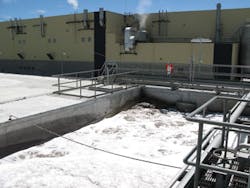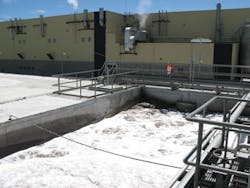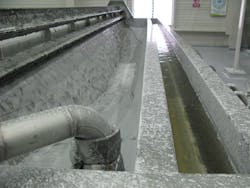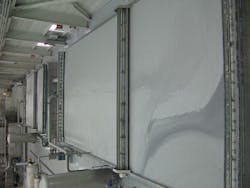Advanced Water Treatment, Recycling Lower Paper Mill Water Consumption
By Kaila Olli, Pajuniemi Petri and Siivonen Mikko
The Pulp and Paper industry has traditionally consumed a lot of fresh water and energy. During the past decades increased attention has been paid to the overall efficiency of paper mills and also to the environmental footprint of the industry. Water management has become a more important factor in the industry. Reasons include a need for cost savings, limited water resources, environmental impacts and legislation.
The industry has seen energy costs rise, environmental legislation tighten all around the world and water resource shortages become a growing concern in many parts of the globe. These trends have led to a decline in the use of fresh water in the paper industry and an increase in water recycling.
One could imagine that expanding water recycling by adding treatment units in a paper mill is a relatively simple task, but in reality it is not that easy. Adding water recycling processes, and at the same time handling possible risks and pitfalls, requires an overall understanding of processes, chemistry and conditions, not only in the paper industry in general, but also of the particular mill in question.
A particular risk in water recycling is that certain impurities and substances will concentrate in process waters, causing serious problems in equipment, processes and product quality. Still, with the knowhow and correct technology, there are many opportunities for water recycling at paper mills.
Mill Differences
Water consumption varies from >5 m3/t up to >100 m3/t between mills, depending on production, raw materials and technologies used in pulp and paper making and related processes. In tissue production, water consumption is higher than in many other grades like newsprint or fine paper and can range from 8-100 m3/t. This is because tissue products have very high quality standards in odor, brightness and texture, which leads to washings and higher demand of fresh water.
Tissue mills using recycled paper as raw material have a lot of challenges in tackling quality issues and therefore water management is crucial. With suitable technology fresh water can be replaced with recycled process water in many production points, even at tissue mills, without compromising quality or runnability. Usual points where fresh water can be replaced are, for example, different dilution waters in pulping and stock prep, and shower and washing waters in the machine area.
Case Study
Swedish based SCA is one of the leading international companies in manufacturing of personal hygiene, tissue, packaging, paper and forestry products and is currently the third largest tissue manufacturer in the world.
SCA's newest mill in North America was officially inaugurated in Sahagun, Mexico, in 2011. Contract for this modern tissue mill was awarded to Metso. Owing to the long collaboration between Metso and Ovivo, Ovivo Finland supplied water treatment equipment and related design work for this project. Environmental factors were on top of the list in this Greenfield project with tight standards in energy conservation and restricted fresh water resources in Mexico on focus. This efficient and modern tissue mill using purely recycled paper consists of a 60,000 ton machine, de-inked pulp (DIP) line, tissue converting hall, distribution center and integrated wastewater treatment plant.
Water Solutions
Ovivo's solutions in the Sahagun project consist of an integrated wastewater treatment plant and water reuse as well as two process water units, Save-all DAF (Dissolved Air Flotation) and DIP DAF. Also, apart from Ovivo's water solutions, the SCA project team uses rain water collected and stored in a pond for further use.
DAF and MBBR technologies
Two major technologies used by Ovivo are FlooDaf® Microflotation and FlooBed® MBBR (Moving Bed Biofilm Reactor). In the DAF system, solids are lifted up by using dispersion water and then scraped off. Heavier solids are collected from the basin bottom with removal equipment. Dispersion water is prepared in a dispersion water tank, where air is dissolved under pressure. This water is pumped into a flotation basin where oversaturation of air releases microbubbles, lifting solids up. Flock formation is improved with suitable flocculant.
FlooBed® MBBR is an aerobic biological wastewater treatment system. The process is easy to operate because it is insensitive to peaks of organic load and variations in flow rate. Micro-organisms, which are mostly attached to plastic carriers, reduce the organic load. Ovivo's carrier elements have a large protected surface area and a density close to water density. The plastic carriers build a floating bed inside the reactor volume.
In traditional fixed-film systems, clogging caused by excess sludge growth has been a risk. In the FlooBed® MBBR process this risk is minimized by the optimized design of the carrier size and shape and by having efficiently mixed reactor conditions. The entire reactor volume is totally mixed by a specially designed bottom aeration system. Consequently there is no "dead" or "unused" space in the reactor. In addition, there is no need for backwashing. Space demand for a FlooBed® DAF system is 3-4 times lower than in a conventional activated sludge system plus a clarifier.
Wastewater Treatment
Waste water treatment in Sahagun consists of a primary treatment with DAF, biological treatment using MBBR technology and a secondary treatment with DAF. As water use and lower energy consumption were an important part of the project, they had to be considered in the design of the wastewater treatment plant, not just in process water solutions. In order to use water from the wastewater treatment plant, it was important to have a reliable treatment process. For solids removal Ovivo's FlooDaf® Microflotation was chosen as it is efficient, but still has a small footprint and is practical and easy to use. MBBR technology is more resistant to possible disturbances (for example solids flush out) than an activated sludge system, which is important as there is a recycling downstream from biological treatment.
In Sahagun, part of the recycled water is taken from the primary DAF system and a larger part from secondary DAF. Almost half of the water from wastewater treatment can be recycled back to the tissue mill.
Process Water Treatment
Two DAF systems are also used for process water treatment in the mill. Ovivo's Save-All DAF is used to treat machine waters, while its DIP DAF system is used on the de-inked pulp line.
The Save-All DAF's main purpose is to collect fiber that has been lost mainly in the wire section and to clean and recycle the water. Treated water from the system can be re-used in consistency control on the machine, for example in the headbox, stock prep or it can be used in showers instead of fresh water.
When the tissue mill is using waste paper as the primary raw material, the DIP process with different cleaning stages becomes very important. There are different types of impurities in waste paper that have to be removed prior to it being used in tissue machines. Removing ink, colloids and sticky substances is important for trouble free operation. "Stickies" are a major problem in DIP based mills. Main sources for stickies are adhesives used in papers. Stickies damage paper quality causing holes and have negative impact on runnabillity (sheet breaks, dirt on cylinders, etc.), which all lead to significant losses of time and money.
At Sahagun mill Ovivo's DIP DAF is used in the second treatment loop, where DIP is cleaned further. Incoming waters to the DIP DAF are excess drain waters from the first loop.
Implementation and Results
Today, Sahagun Mill reaches the Integrated Pollution Prevention and Control (IPPC) Directive's BAT (Best Available Technology) levels for a DIP tissue mill. The target has been to reach fresh water usage as low as 12 m3/t. This is an ambitious aim, but realistic as production is continuously being optimized for better efficiency.
Almost half of the water coming to the WWTP is recycled back to the mill. This recycled water is used in DIP dilution tanks to control consistency in the DIP line.
Consistency of 4% in the recollected fiber is steadily achieved in Sahagun with the Save-All DAF. Clean water is used in shower waters and consistency control in the machine. The goal for treated water suspended solids (SS) from the Save-All DAF was <60 mg/l and this has been achieved, with results typically around 20 mg/l.
Thanks to the DIP DAF the reduction of solids has also been up to 98%. Collected sludge is directed to sludge handling at the moment, but there are plans to screen this sludge and re-use useful fibers. Water is directed from the DAF to DIP filtrate tank and is further used in washings and consistency control in the DIP line. The limit for treated water SS in the DIP DAF was <200 mg/l which has been achieved, with results being typically under 50 mg/l.
About the Authors: Olli Kaila has an engineering degree in biotechnology and works as a Specialist of process and wastewater treatment solutions at Ovivo Finland. Petri Pajuniemi has a master's degree in environmental sciences and has global responsibility for MBBR-based process and wastewater treatment solutions at Ovivo. Mikko Siivonen has a master's degree in environmental sciences and is responsible for the global pulp and paper water and wastewater treatment market at Ovivo.



